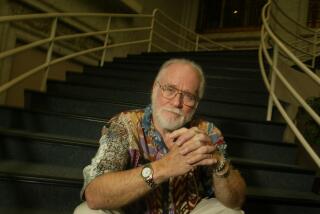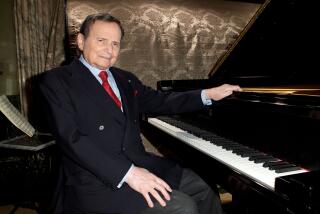George Zoritch dies at 92; ballet star and teacher
George Zoritch, an international ballet star who had a second career as a well-respected teacher, died Nov. 1 at Carondelet St. Mary’s Hospital in Tucson. He was 92.
His death was confirmed by a spokeswoman for the law firm representing his estate. The cause was not given.
Zoritch had retired in 1987 from teaching dance at the University of Arizona. He also taught at his studio in West Hollywood and had several stage and film credits.
Zoritch was best known for his work with the Ballet Russe companies starting in the 1930s. His dashing good looks complemented what Dance Magazine in 2000 called “his ability to delve deeply into the heart of a character and to embody the essence of emotion in a restrained, elegant fashion.”
“He had a lot of feeling when he danced,” said Paul Maure, a fellow Ballet Russe dancer who knew Zoritch for more than 60 years. “Technique is important, but you have to feel what you do. Zoritch had everything.”
Born June 6, 1917, in Moscow, Zoritch started his training in Lithuania under Pavel Petroff when he was 11.
“I went to train for the first time and [Petroff] . . . asked if I would be able to follow,” Zoritch told the Arizona Daily Star in 2007. “I was so scared I just nodded yes.
“When we finished, people in the class had surrounded me, asked where I studied before and how long I had studied. All I did was look around and went along with what others were doing. I wouldn’t say I was God’s gift. But I was right for ballet.”
Zoritch and several Ballet Russe contemporaries were honored in 2007 at a Los Angeles tribute. Two years earlier, the documentary “Ballets Russes” brought renewed attention to Zoritch and his contemporaries.
“He was a very charming man who still had a lot to tell the ballet world,” said Natasha Middleton, artistic director of the Media City Ballet, who produced “The Men of the Ballet Russe” tribute in 2007 that also honored her father, Andrei Tremaine.
“Technique doesn’t sell,” Zoritch told The Times in 2007. “It’s what you offer from the heart, and what made Ballet Russe so successful was that it was composed of half-starved ballet-craving dancers who gave everything from their inner souls.”
Milada Mladova, who was with the Ballet Russe from 1939 to 1942 and later worked in movies, danced with Zoritch in “Night and Day” (1946).
“He had a perfect body for dancing, and he had very good technique,” she said. “We were all in awe of him, but he was a very nice man.”
Zoritch’s other film credits include “Escape Me Never” (1947), “Look for the Silver Lining” (1949) and “Helen of Troy” (1956).
Zoritch taught at his studio in West Hollywood in the 1960s and in 1973 joined the faculty at the University of Arizona.
“He gave us careers, he gave us a life,” said Leonard Crofoot, who with his brother, Ronnie, and sister, Gayle, took classes at Zoritch’s studio from 1960 to 1967. They all have danced professionally. “He had a way of turning the head to the side that shows the muscles of the neck and you could see the line in such a graceful way. It took your breath away.”
Middleton recalled Zoritch teaching a master class at her Burbank studio in 2007 from a wheelchair. “He was still able to move his hands . . . and go into depth about the dancers finishing their movements. He had a lot of magic in the way he spoke,” she said. “He was very encouraging . . . and very, very opinionated.”
Zoritch had no immediate survivors.
More to Read
The biggest entertainment stories
Get our big stories about Hollywood, film, television, music, arts, culture and more right in your inbox as soon as they publish.
You may occasionally receive promotional content from the Los Angeles Times.






